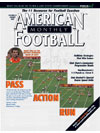AMERICAN FOOTBALL MONTHLY THE #1 RESOURCE FOR FOOTBALL COACHES
Article CategoriesAFM Magazine
|
The Pass Action RunHow Macalester Sells the Pass in Order to Runby: Mike Kuchar © More from this issue The Origins Like many innovative designs in football, Glenn Caruso stumbled upon the next great offensive concept by chance. As a coordinator at the University of South Dakota in 2004, the Coyotes were cruising through their high rep, high tempo daily play polish period until something, or someone, kept putting a massive dent in their plans. “We kept trying to run the weak side isolation play out of pro slot, but that Will linebacker kept smacking us in the face. We couldn’t get him blocked,” said Caruso. “So we decided the best thing we could do is influence him.” The next play, Caruso told his quarterback on the snap to fake the bubble screen to the slot receiver and then get the ball deep to the tailback. “The Will eventually made the play, but the slot bubble caused him to widen, giving us a nice crease in t....The full article can only be seen by subscribers. Subscribe today!
|
|
|||||||
| HOME |
MAGAZINE |
SUBSCRIBE | ONLINE COLUMNISTS | COACHING VIDEOS |
Copyright 2025, AmericanFootballMonthly.com
All Rights Reserved





